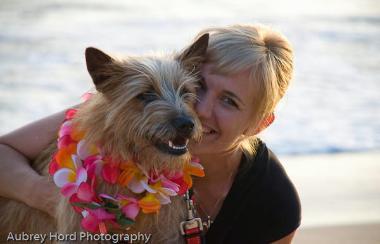Finding the balance with babies and dogs is possible, but may feel overwhelming in the beginning. One of my favorite movies when I was a child was Disney’s Lady and the Tramp. A line that I remember from that movie is, “when the baby moves in, the dog moves out”. Lady and the Tramp was released in 1955 but the sentiment of that statement still rings true today.
I had my first child when I was 21. At the time, I worked full time at an animal welfare organization and had three dogs of my own (an Australian Shepherd and two pit bull mixes). I was also fostering a special needs puppy. I had my second child a few years later. I raised my children in a multiple dog home. It can be done with the right tools.
Supervision, Management, Training
These are the keys to balancing dogs and babies. Dogs are very adaptable. For many families, dogs were the first “babies”, before the human babies came along. Many new mothers feel guilty that they will not be able to give their dogs enough attention now that their first priority is their baby. It is perfectly understandable to have these feelings. It is perfectly okay for the dog to take the back seat at many times in our often hectic lives. Hiring a certified professional dog trainer who specializes in Dog & Stork training can help you have a personalized plan in place before baby arrives and address specific concerns once baby is here.
Integration
As a dog trainer and behavior counselor, my goal is to help the family integrate. Your dog loves you, and for many dogs, you are the only family that he has known—especially if your dog is over the age of six. Old dogs can learn new tricks and they can adjust to new living situations. It is our job to bridge the communication gap and to help them learn the new rules.
Communication
Dogs are very smart…they just don’t speak English. So dogs will growl, snap, and perhaps bite if their warnings are ignored. As mothers, it is our job to protect our children and our dogs. Growling is good. It lets us know how are dogs are feeling. It is your signal to remove your dog from a situation that is stressful to a place of safety. You wouldn’t expect your 80 year old relative to watch your toddler all day, so it only makes sense that your senior dog should have a child free space. Until children are old enough to learn boundaries, it is our job as parents to set them.
Safety Zones. Safe zones are critical
There need to be separate areas where our children can roam without the dog there and where the dog can snooze without a child in his space. Children and dogs should never be unsupervised. It doesn’t matter how well you know your dog, they should never be left unsupervised. Time shared space is a great way to integrate a harmonious living situation. For example, when your child is napping, your dogs can hang out with you. If your child is cruising the living room, the dog should be in a space behind a baby gate or in the yard.
Appropriate Timing
Don’t feel guilt about not giving your dog enough time. Your dog appreciates being a part of your family. Dogs are crepuscular, meaning they are active during dawn and dusk. Give your dog 5 to 10 minutes of mental exercise (sit, down, tricks, etc.) and 20 minutes of physical exercise (walks, playing fetch, etc.). Schedule time with your dog around when you aren’t busy with the kids.
Different Stages, Different Rules
As your baby grows, there are so many different stages of development. During each stage, you will need to adjust the rules for your dog so that everyone can live harmoniously.
As your children grow, start teaching them to respect your dog’s space, as well as how to stay safe by teaching them how dogs communicate. Do teach your dog not to jump on your child by teaching him a polite greeting. Do teach your dog where his spot is in every room. Do teach your dog when to go outside or in the bedroom. Do teach your children to leave the dog alone while he is eating, sleeping or chewing on his toys. Do teach your children how to appropriately pet dogs.
There are a lot of resources to help your raise your child with dogs. Don’t give up, get help. Dogs and children can be lifelong friends. Children often make the best dog trainers. To get help making your home more harmonious, feel free to contact me at ohanapet@gmail.com, I would love to help.
About the Author
 Lisa Giesick, mother of two, has worked with animals for over 30 years. She is a CPDT-KA dog trainer and the owner of Ohana Pet. Her educational background includes child development, psychology, criminology, and basic & advanced Humane Academies. Lisa lives on the island of Maui with her four dogs, six cats, turtle, and husband.
Lisa Giesick, mother of two, has worked with animals for over 30 years. She is a CPDT-KA dog trainer and the owner of Ohana Pet. Her educational background includes child development, psychology, criminology, and basic & advanced Humane Academies. Lisa lives on the island of Maui with her four dogs, six cats, turtle, and husband.

